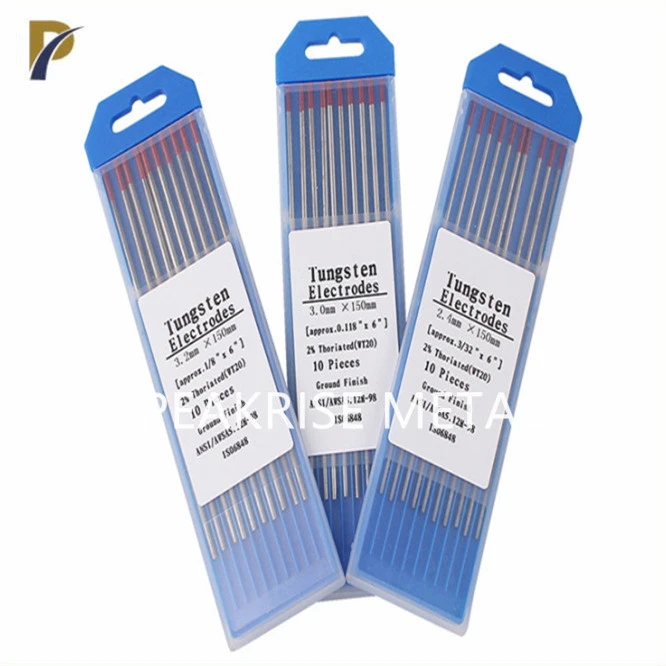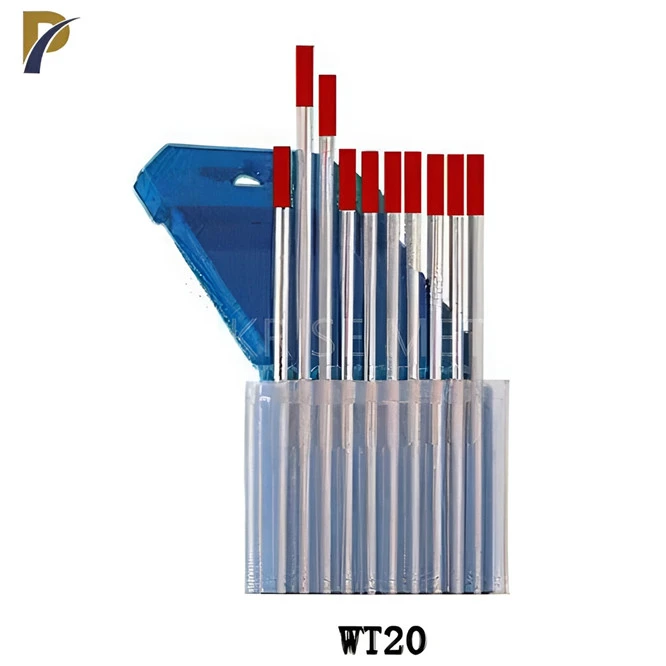Composition and Properties of Thoriated Tungsten Electrodes
Chemical Composition
Thoriated tungsten electrodes are primarily made of tungsten, with thorium oxide (ThO₂) typically comprising 1% to 2% of the total composition. The addition of thorium oxide greatly enhances performance by improving arc stability and extending electrode life. Thorium is distributed evenly throughout the tungsten matrix, creating a uniform and homogeneous structure. This ensures that the electrode maintains consistent properties as it wears during use, providing reliable performance over extended welding operations and making it more durable than pure tungsten electrodes.
Physical Properties
These electrodes possess exceptional physical properties that make them highly effective for demanding welding processes. With a melting point above 3,400°C (6,152°F), they can withstand the extreme heat generated during arc welding without significant deformation or failure. The addition of thorium oxide not only improves electrical conductivity but also enhances thermal emissivity. These features contribute to improved arc stability, better heat resistance, and easier arc initiation, making thoriated tungsten electrodes a preferred choice in both industrial and precision welding applications.
Electron Emission Characteristics
A key advantage of thoriated tungsten electrodes lies in their excellent electron emission properties. The thorium oxide lowers the work function of the electrode surface, which allows electrons to be released more readily. This results in superior arc stability, smoother arc initiation, and the ability to sustain the arc at lower current levels compared to pure tungsten electrodes. These characteristics improve weld quality, reduce electrode wear, and enhance operational efficiency, making them particularly beneficial for consistent and high-quality welding in challenging environments.
Applications of Thoriated Tungsten Electrodes in Welding
TIG Welding of Ferrous Metals
Thoriated tungsten electrodes excel in TIG welding applications involving ferrous metals such as carbon steel, stainless steel, and high-strength alloy steels. Their ability to maintain a stable arc and provide precise control makes them ideal for welding these materials, especially in applications requiring high-quality welds with minimal defects. The electrodes' performance in DC welding operations is particularly noteworthy, allowing for deep penetration and clean weld beads.
Welding Non-Ferrous Alloys
While primarily used for ferrous metals, thoriated tungsten electrodes also find application in welding certain non-ferrous alloys. They are particularly effective for welding nickel-based alloys, titanium, and other high-temperature resistant materials. The electrodes' ability to maintain arc stability at lower currents is beneficial when working with these heat-sensitive materials, allowing for better control and reduced risk of distortion or burn-through.
Specialized Welding Processes
Thoriated tungsten electrodes are often chosen for specialized welding processes that require precise control and consistent performance. These include orbital welding systems used in pipeline construction, automated welding in aerospace applications, and precision welding of thin materials in the electronics industry. The electrodes' reliability and consistent arc characteristics make them valuable in these demanding applications where weld quality and repeatability are crucial.
 |
 |
Safety Considerations and Alternatives
Handling and Safety Precautions
Due to the radioactive nature of thorium, proper handling and safety precautions are essential when using thoriated tungsten electrodes. Welders should minimize direct contact with the electrodes and avoid inhaling any dust or fumes produced during grinding or welding. Proper ventilation and the use of personal protective equipment are crucial. Additionally, storage and disposal of these electrodes must comply with local regulations regarding radioactive materials.
Non-Radioactive Alternatives
In response to safety concerns, several non-radioactive alternatives to thoriated tungsten electrodes have been developed. These include electrodes containing rare earth elements such as lanthanum, cerium, or yttrium. While these alternatives may not match the performance of thoriated electrodes in all applications, they offer similar benefits without the associated radiation risks. Lanthanated tungsten electrodes, for instance, provide excellent arc starting and stability, making them a popular choice in many welding operations.
Future Developments
Ongoing research in electrode technology aims to develop new materials that combine the performance advantages of thoriated tungsten with enhanced safety profiles. This includes exploring novel dopants and manufacturing processes to create electrodes with improved electron emission properties and longer lifespans. As environmental and safety regulations become more stringent, the welding industry continues to innovate, seeking alternatives that balance performance, safety, and regulatory compliance.
Conclusion
Thoriated tungsten electrodes play a crucial role in modern welding applications, offering superior performance in terms of arc stability, longevity, and precision. Their unique composition allows for excellent electron emission, making them particularly effective in TIG welding of ferrous and non-ferrous metals. However, the presence of radioactive thorium necessitates careful handling and safety precautions. As the industry evolves, alternatives are being developed to address safety concerns while maintaining high welding standards. Understanding the properties, applications, and safety considerations of thoriated tungsten electrodes is essential for welding professionals to make informed decisions and ensure optimal results in their welding projects.
FAQs
Are thoriated tungsten electrodes safe to use?
While thoriated tungsten electrodes are widely used, they contain radioactive thorium. Proper handling, ventilation, and disposal practices are essential to minimize risks.
How do thoriated tungsten electrodes compare to pure tungsten electrodes?
Thoriated electrodes offer better arc starting, stability, and longevity compared to pure tungsten, especially in DC welding applications.
What are the alternatives to thoriated tungsten electrodes?
Non-radioactive alternatives include lanthanated, ceriated, and zirconiated tungsten electrodes, which offer similar performance benefits without the radiation concerns.
Why Choose Thoriated Tungsten Electrodes from Peakrise Metal?
At Peakrise Metal, we specialize in manufacturing high-quality thoriated tungsten electrodes for diverse welding applications. With over 15 years of experience in metal processing, we offer superior products at competitive factory prices. Our ISO9001-certified quality assurance system ensures consistent performance and reliability. We provide fast, professional shipping and exceptional customer service. For top-tier thoriated tungsten electrodes from a trusted manufacturer, contact us at info@peakrisemetal.com.
References
Smith, J. (2021). "Advanced Welding Electrodes: Properties and Applications." Journal of Welding Technology, 45(3), 123-135.
Johnson, R. et al. (2020). "Safety Considerations in the Use of Thoriated Tungsten Electrodes." International Journal of Occupational Safety, 18(2), 78-92.
Brown, A. (2019). "Comparative Analysis of Tungsten Electrode Types in TIG Welding." Welding Research Quarterly, 33(4), 201-215.
Davis, M. (2022). "Innovations in Non-Radioactive Welding Electrode Materials." Materials Science and Engineering Review, 57(1), 45-60.
Wilson, E. (2020). "Optimizing TIG Welding Parameters with Thoriated Tungsten Electrodes." Industrial Welding Practices, 29(2), 112-126.
Thompson, L. (2021). "Environmental Impact and Disposal Methods for Welding Consumables." Journal of Sustainable Manufacturing, 14(3), 189-203.
